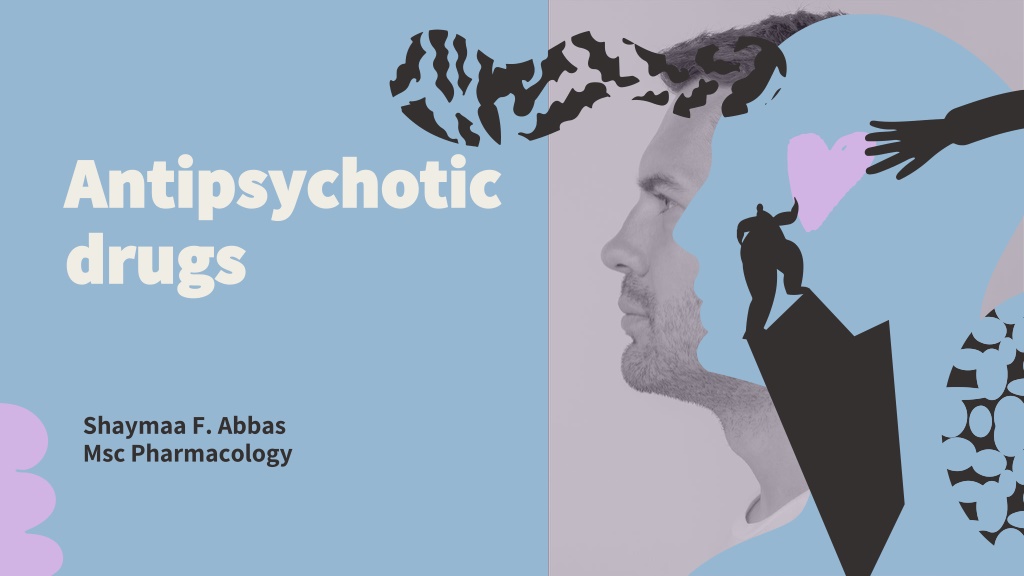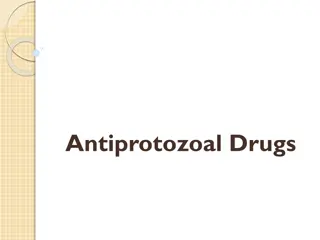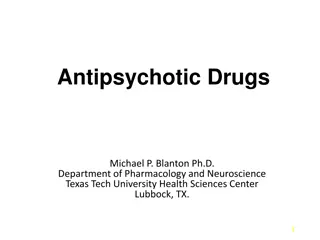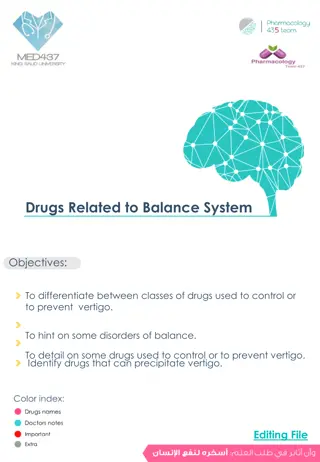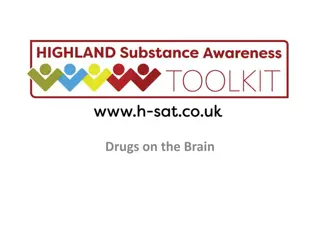Understanding Antipsychotic Drugs and Their Classification
Antipsychotic drugs, also known as neuroleptics, are essential in treating schizophrenia and other psychotic disorders. They work by targeting dopamine and serotonin receptors in the brain, managing symptoms like hallucinations and delusions. Learn about the dopamine-serotonin hypothesis of schizophrenia, classification of antipsychotic drugs (typical and atypical), their side effects, and how to manage them effectively.
Download Presentation

Please find below an Image/Link to download the presentation.
The content on the website is provided AS IS for your information and personal use only. It may not be sold, licensed, or shared on other websites without obtaining consent from the author. Download presentation by click this link. If you encounter any issues during the download, it is possible that the publisher has removed the file from their server.
E N D
Presentation Transcript
Antipsychotic Antipsychotic drugs drugs Shaymaa F. Abbas MscPharmacology
Learning objectives 1. Dopamine- serotonin hypothesis of schizophrenia 2. Classification of antipsychotic drugs 3. Basic concepts about their receptors action 4. Basic concepts about their related effects/ side effects and how to manage them
Dopamine Chemoreceptor trigger zone Mesolimbic pathway Dopamine= vomiting Dopamine= Psychosis Basal ganglia Pituitary gland Dopamine= Prolactin Dopamine= Extrapyramidal symptoms (eg: parkinsonism)
The antipsychotic drugs Psychosis (from the Greek , psyche, "mind ", and -osis, "abnormal condition or derangement") refers to an abnormal condition of the mind The antipsychotic drugs (also called neuroleptics or major tranquilizers) are used primarily to treat schizophrenia, but they are also effective in other psychotic and manic states.
Schizophrenia is a type of chronic psychosis characterized by: 1. Positive symptoms: Thought disorders, Delusions, Hallucinations, Paranoia 2. Negative symptoms: loss of motivation, Social withdrawal, Flat affect, Poverty of speech 3. Cognitive impairment "Dopamine hypothesis": Symptoms arise because of excessive dopaminergic activity in mesolimbic system. Serotonin is increasingly seen as a part of the etiology of schizophrenia. May be linked to negative symptoms
Classification of antipsychotics 1- Typical antipsychotics: 1stgeneration Phenothiazines: Chlorpromazine, Thioridazine, Promethazine Haloperidol: Most likely cause of neuroleptic malignant syndrome (NMS) and Tardive dyskinesia 2-Atypical antipsychotics: 2nd generation Clozapine: Agranulocytosis-requirement for frequent blood test Olanzapine, Risperidone
1stgeneration antipsychotics are more likely to be associated with movement disorders known as extrapyramidal symptoms (EPS), particularly drugs that bind tightly to D2 receptors, such as haloperidol Movement disorders are less likely with medications that bind weakly, such as chlorpromazine.
Mechanism of action of antipsychotics All of the 1stgeneration and most of the 2ndgeneration antipsychotic drugs block D2 receptors in the brain & periphery. Atypical antipsychotics exert part of their action through blocking of serotonin receptors ((5-HT2A )) receptors Some of atypical antipsychotics blocks D1,D4 receptors, with weak affinity to D2 receptors Additional mechanisms for both typical and atypicals: antagonism on 1, Muscarinic , H1
Clinical uses 1. Schizophrenia and schizoaffective states Bipolar disorder 3. Drug or radiation emesis 4. Intractable hiccup chlorpromazine 5. Pruritus promethazine 6. Co-analgesic in chronic pain and terminal illness 7. Others 2.
Side effects of antipsychotics Side effects from dopamine blockade: 1- Dyskinesias (extrapyramidal symptoms [EPS]) mainly with typical(1stgeneration) 1. Reversible EPS: Pseudoparkinsonism (drug-induced parkinsonism), dystonia, akathisia 2. Chronic EPS: Tardive dyskinesia (TD)
Dyskinesias [EPS] Reversible EPS Chronic Drug-induced parkinsonism Dystonia Akathisia Tardive dyskinesia B-blockers or benzodiazepines Discontinuation switch to atypical valbenazine Antimuscarinic drugs (benztropine or diphenhydramine)
Side effects of antipsychotics Tardive dyskinesia this important toxicity includes choreoathetoid movements of the muscles of the lips and buccal cavity and may be irreversible. It tends to develop after several years of antipsychotic drug therapy but may appear as early as 6 months Antimuscarinic drugs generally increase the severity of tardive dyskinesia symptoms.
Side effects dopamine blockade continue 2- Endocrine dysfunction Hyper prolactinemia (galactorrhea, amenorrhea, gynecomastia), sexual dysfunction Metabolic disorders: eating disorders (weight gain), glucose intolerance, dyslipidemia : mainly with atypical 3-Temperature regulation problems (Poikilothermia)
4. Neuroleptic malignant syndrome Rare but fatal adverse effect that can occur at any time during treatment The onset of symptoms is rapid with increased temperature, severe muscular rigidity, confusion, agitation, elevation in WBC count, elevated CPK concentrations, elevated liver enzymes, myoglobinuria, and acute renal failure. The antipsychotic should be immediately discontinued Adequate hydration, cooling, and close monitoring of vital signs and serum electrolytes. Treated with dantrolene and bromocriptine The risk of neuroleptic malignant syndrome is higher with first-generation antipsychotics, Second-generation antipsychotics also cause this adverse effect
Side effects from muscarinic blockade All cause dry mouth except clozapine causes hyper salivation Side effects from -blockade (particularly hypotension) Side effects from H1 blockade: sedation Cardiotoxicity: prolongation of QT interval, myocarditis, sudden death Other side effects 1. Seizure: chlorpromazine, clozapine 2. Immune mediated reactions: Photosensitivity, Cholestatic jaundice-especially with chlorpromazine, agranulocytosis (clozapine)
Long acting formulations Parenteral forms of many agents (e.g. Fluphenazine decanoate, haloperidol decanoate and olanzapine pamoate) are long-acting injectable (LAI) formulations of antipsychotics. These formulations have a therapeutic duration of action of up to 2 to 4 weeks and, therefore, are often used to treat out- patients and individuals who are non-adherent with oral medications
Typical Vs. Atypical DA and 5HT D1+D2+D4+5HT Treat POSITIVE and NEGATIVE symptoms Lesser EPS Useful in refractory disease Mainly DA Mainly D2 Treat mostly POSITIVE symptoms More EPS adverse effects Less useful in refractory disease
A woman taking haloperidol developed a spectrum of adverse effects that included the amenorrhea-galactorrhea syndrome and extrapyramidal dysfunction. Another, newer, antipsychotic drug was prescribed which however caused weight gain and hyperglycemia due to a diabetogenic action. The drug prescribed was (A) Bupropion (B) Chlorpromazine (C) Fluoxetine (D) Lithium (E) Olanzapine
The reason why clozapine causes less extrapyramidal dysfunction than haloperidol when used in schizophrenia is that in the CNS, clozapine (A) Activates GABA receptors (B) Blocks dopamine release (C) Has greater antagonism at muscarinic receptors (D) Has a low affinity for dopamine D2 receptors (E) Is an -receptor agonist
A young male patient recently diagnosed as schizophrenic develops severe muscle cramps with torticollis a short time after drug therapy is initiated with haloperidol. The best course of action would be to (A) Add risperidone to the drug regimen (B) Discontinue haloperidol and observe the patient (C) Give oral diphenhydramine (D) Inject benztropine (E) Switch the patient to fluphenazine
Thank you Thank you
